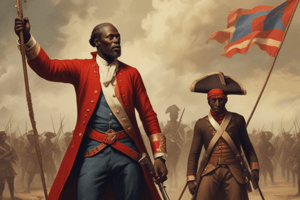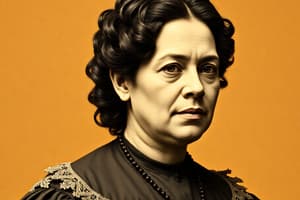Podcast
Questions and Answers
What was the concern of upper-class whites regarding James Forten's daughter?
What was the concern of upper-class whites regarding James Forten's daughter?
- She was rumored to be dating a white man.
- She might intermarry with a white person for social status. (correct)
- She was to marry a wealthy black man.
- Her marriage would be advantageous for black people.
Which group supported black progress but remained conservative regarding social interaction?
Which group supported black progress but remained conservative regarding social interaction?
- Urban reformers
- Southern plantation owners
- Liberal Quakers (correct)
- Wealthy industrialists
What did the publisher of a guide to brothels question regarding societal norms?
What did the publisher of a guide to brothels question regarding societal norms?
- The legality of interracial relationships
- The morality of mixed-race societies
- The taste of clients in brothels (correct)
- Public acceptance of black men in brothels
What was the outcome of the 1849 riot in Philadelphia?
What was the outcome of the 1849 riot in Philadelphia?
What seemingly accepted interracial relationship was noted among Philadelphia whites?
What seemingly accepted interracial relationship was noted among Philadelphia whites?
What was implied as a possible reason for the 1849 riot specifically targeting a tavern?
What was implied as a possible reason for the 1849 riot specifically targeting a tavern?
How did prominent black Philadelphians establish connections with the outside world in the 1820s?
How did prominent black Philadelphians establish connections with the outside world in the 1820s?
What role did Francis Johnson play in bridging connections between black Philadelphia and the wider community?
What role did Francis Johnson play in bridging connections between black Philadelphia and the wider community?
What does 'race mixing' refer to in the nineteenth-century context discussed?
What does 'race mixing' refer to in the nineteenth-century context discussed?
How did some reformers view racial intermixing?
How did some reformers view racial intermixing?
Who were some prominent black caterers mentioned as having connections to white Philadelphia power figures?
Who were some prominent black caterers mentioned as having connections to white Philadelphia power figures?
What did black abolitionists share with their communities upon returning from organizing activities?
What did black abolitionists share with their communities upon returning from organizing activities?
What significant action did John Bowers experience in a Lancaster hotel regarding his rights?
What significant action did John Bowers experience in a Lancaster hotel regarding his rights?
What was the overall sentiment of the white abolitionists during Bowers' experience?
What was the overall sentiment of the white abolitionists during Bowers' experience?
What did the incident experienced by John Bowers reveal about the attitudes of abolitionists?
What did the incident experienced by John Bowers reveal about the attitudes of abolitionists?
During the 1820s, what was a common way for black Philadelphians to stay informed about the outside world?
During the 1820s, what was a common way for black Philadelphians to stay informed about the outside world?
What was the primary reason the Philadelphia meetings aimed to drop the designation 'African'?
What was the primary reason the Philadelphia meetings aimed to drop the designation 'African'?
Which value was NOT identified as a key to achieving respectability in American society?
Which value was NOT identified as a key to achieving respectability in American society?
What specifically did the Philadelphia black leader indicate as essential to their growth?
What specifically did the Philadelphia black leader indicate as essential to their growth?
According to the leaders of the black community, what was one major purpose of education?
According to the leaders of the black community, what was one major purpose of education?
Which of the following best reflects the influence of liberal Quaker ideology in the goals set by the black community?
Which of the following best reflects the influence of liberal Quaker ideology in the goals set by the black community?
What was the anticipated effect of education on the community, as perceived by its leaders?
What was the anticipated effect of education on the community, as perceived by its leaders?
Which of the following is an incorrect assumption about the goals established by the black community leaders?
Which of the following is an incorrect assumption about the goals established by the black community leaders?
Which aspect was emphasized as fundamentally detrimental to both individuals and society according to the black community leaders?
Which aspect was emphasized as fundamentally detrimental to both individuals and society according to the black community leaders?
What were common targets during the riots against the black community between 1834 and 1849?
What were common targets during the riots against the black community between 1834 and 1849?
Which year saw the destruction of the Quaker Shelter for Colored Orphans?
Which year saw the destruction of the Quaker Shelter for Colored Orphans?
What does the term 'Ameri-canization' refer to in the context provided?
What does the term 'Ameri-canization' refer to in the context provided?
During the riots, which type of establishments were notably spared by the rioters?
During the riots, which type of establishments were notably spared by the rioters?
What notable event occurred in the summer of 1835 among the black community?
What notable event occurred in the summer of 1835 among the black community?
What type of property was a frequent target during these riots, representing success in the black community?
What type of property was a frequent target during these riots, representing success in the black community?
Which characteristic was noted as a differentiator among antebellum urban blacks?
Which characteristic was noted as a differentiator among antebellum urban blacks?
What was one outcome of the tensions within the black community on their relations with the white community?
What was one outcome of the tensions within the black community on their relations with the white community?
What was the primary intent of the group's commitment to education and temperate living?
What was the primary intent of the group's commitment to education and temperate living?
What was one of the causes noted for the 1834 riots involving the Philadelphia black community?
What was one of the causes noted for the 1834 riots involving the Philadelphia black community?
What criticism did some black leaders express towards the elite's approach to gaining respectability?
What criticism did some black leaders express towards the elite's approach to gaining respectability?
What was the reaction of some members of the black community towards their fellows who used direct confrontational measures?
What was the reaction of some members of the black community towards their fellows who used direct confrontational measures?
How did some Philadelphia leaders' views shift as the mid-century approached?
How did some Philadelphia leaders' views shift as the mid-century approached?
What was a common sentiment about the actions of dissenting black leaders towards white slaveholders?
What was a common sentiment about the actions of dissenting black leaders towards white slaveholders?
Which aspect of Afro-American life saw a decline in commitment from national black organizations?
Which aspect of Afro-American life saw a decline in commitment from national black organizations?
What led to the growing belligerence in public statements from some black leaders?
What led to the growing belligerence in public statements from some black leaders?
Flashcards are hidden until you start studying
Study Notes
Communication and Connections
- In the 1820s, informal connections between prominent Black Philadelphians and their white counterparts were developing.
- Musician Francis Johnson facilitated cultural exchange between Black communities and white society in Pennsylvania and New York.
- Black caterers like Robert Boggle interacted with influential white figures such as Nicholas Biddle.
Abolitionist Activities
- Black abolitionists traveled widely for organizing and gathered support from wealthy patrons, sharing news and experiences with their communities.
- John's Bowers' report illustrated the collaboration between white and Black abolitionists, showcasing action against racial discrimination in public spaces.
Racism and Social Dynamics
- Upper-class white residents ambivalently viewed Black aspirations for social mobility, as seen in attitudes towards James Forten's family.
- Liberal Quakers supported Black progress but maintained conservative limits on social interactions with Black individuals.
- An 1849 riot in Philadelphia highlighted tensions around interracial relationships and social mobility.
Movement for Respectability
- The national Convention of Free People of Color urged the adoption of “Colored Americans” over “African” to assert their American identity.
- Key principles of this movement included frugality, education, temperance, and morality as pathways to respectability in society.
Educational Aspirations
- Education was prioritized within the Black community as a means to combat negative perceptions and improve social status.
- The elite believed living moral lives could refute degrading stereotypes about Black individuals.
Rising Tensions
- A portion of the Black community grew dissatisfied with constraints imposed by white societal norms and began to express discontent.
- Confrontations with authorities emerged, partially contributing to the riots from 1834 to 1849, as many sought to resist oppression actively.
Impact of Riots
- Major riots led to the destruction of symbols of Black success—such as churches and community halls—indicating targeted racial aggression.
- Attacks focused on institutions representing Black progress while largely ignoring venues associated with interracial interaction.
Class Dynamics within the Black Community
- Differences in values between the elite and working-class Blacks influenced their interactions with white society.
- The "domino effect" of intrablack conflicts manifested in public mockery of those seen as not conforming to mainstream “American” values.
Studying That Suits You
Use AI to generate personalized quizzes and flashcards to suit your learning preferences.




